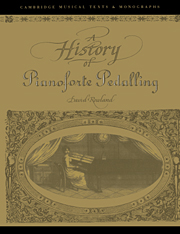Book contents
- Frontmatter
- Contents
- Acknowledgements
- List of abbreviations
- Introduction
- PART I The instruments
- PART II Pedalling and the early pianists
- PART III Pedalling after c.1800
- APPENDIX: Chapters on pedalling from piano tutors
- J. P. Milchmeyer, Die wahre Art das Pianoforte zu spielen. Chapter 5 (Dresden 1797)
- Louis Adam, Méthode de piano du Conservatoire, Chapter 10: The manner of using the pedals (Paris 1804)
- Daniel Steibelt, Méthode de piano (Paris and Leipzig 1809)
- Notes
- Select bibliography
- Index
J. P. Milchmeyer, Die wahre Art das Pianoforte zu spielen. Chapter 5 (Dresden 1797)
Published online by Cambridge University Press: 16 November 2009
- Frontmatter
- Contents
- Acknowledgements
- List of abbreviations
- Introduction
- PART I The instruments
- PART II Pedalling and the early pianists
- PART III Pedalling after c.1800
- APPENDIX: Chapters on pedalling from piano tutors
- J. P. Milchmeyer, Die wahre Art das Pianoforte zu spielen. Chapter 5 (Dresden 1797)
- Louis Adam, Méthode de piano du Conservatoire, Chapter 10: The manner of using the pedals (Paris 1804)
- Daniel Steibelt, Méthode de piano (Paris and Leipzig 1809)
- Notes
- Select bibliography
- Index
Summary
In large towns, there are always many craftsmen who make pianos and you have a choice. Nevertheless, I now advise every amateur who wishes to purchase a piano that he shouldn't balk at the thought of paying 20 – 30 thaler. A good instrument is like a fine painting, and likewise is worth two or three times as much after the death of the master. If you are able to choose between various types of instruments, I would recommend that greater preference be given to the small, square piano. The grand piano takes up more space, is more expensive to take around on journeys, and has fewer mutations than the square, even though these mutations produce so many effects and gain ever-increasing approval. In the case of grand pianos, I have also found that the two highest octaves seldom have a proportionately beautiful, resonant and incisive tone; the bass notes are more often than not extraordinarily strong and the upper notes thin, so that an instrument of this kind resembles a gentleman in a poor suit accompanied by a magnificently clothed servant, or a large man, seven feet tall, whose voice resembles that of a child. If the tone and mutations of grand pianos were correspondingly more beautiful than those of the square, I would be the first to recommend them, but as yet I have very seldom found this to be the case, and I therefore find myself having to return to the little square, and when investigating its excellence, pointing out features that we have just observed.
- Type
- Chapter
- Information
- A History of Pianoforte Pedalling , pp. 159 - 169Publisher: Cambridge University PressPrint publication year: 1993



